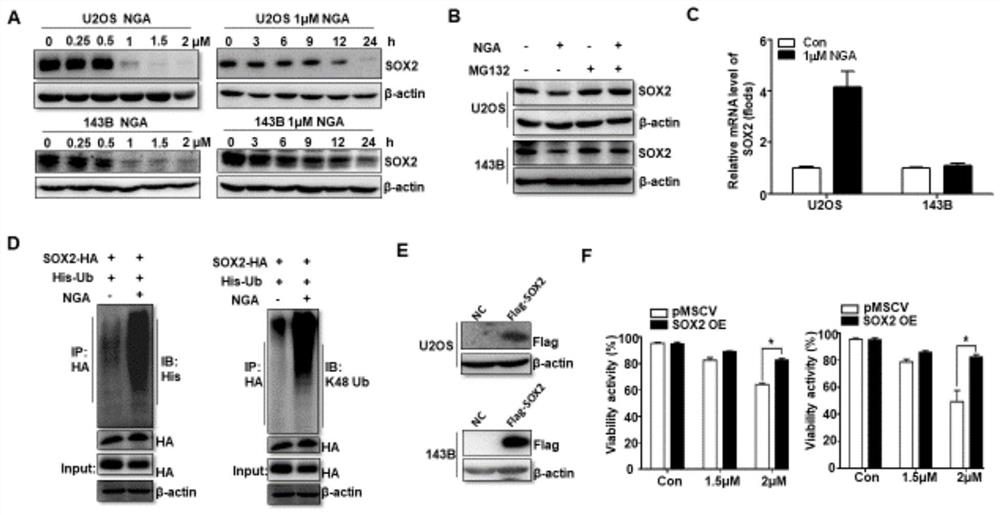Application of USP9x inhibitor in preparation of medicine for treating osteosarcoma
An inhibitor and osteosarcoma technology, applied in the application field of USP9x inhibitors in the preparation of osteosarcoma drugs, can solve the problems of few clinical application reports, and achieve the effects of avoiding adverse reactions, inhibiting proliferation, and promoting ubiquitination and degradation
- Summary
- Abstract
- Description
- Claims
- Application Information
AI Technical Summary
Problems solved by technology
Method used
Image
Examples
Embodiment 1
[0036] Example 1. NGA can inhibit osteosarcoma cell proliferation and promote cell apoptosis.
[0037] Through a series of CCK8 experiments and apoptosis detection screening, we found that NGA can cause obvious proliferation inhibition and apoptosis of osteosarcoma cells U2OS and 143B cells in a time-dependent manner. At the same time, it can effectively inhibit the clone formation ability of tumor cells.
[0038] Experimental process: After treating U2OS, 143B and MG63 cells with different concentrations of NGA for 24h or 48h, the cell proliferation was detected by CCK8 assay, and it was found that NGA could significantly inhibit cell proliferation (see figure 1 ). Then we treated U2OS cells with 0.25, 0.5, 1.0, 1.5, and 2.0 μM NGA for 24 hours, and Western Blot analysis found that NGA could significantly induce cell apoptosis, and the activation of PARP and Caspase3 appeared (see figure 2 A-B), further using AnnexinⅤ-APC and PI double-staining technique, flow cytometry an...
Embodiment 2
[0039] Example 2. NGA effectively promotes the degradation of SOX2, thereby exerting an anti-tumor effect.
[0040] It has been reported in the literature that the high expression of SOX2 effectively promotes the proliferation of tumor cells and the rapid progression of tumors, but according to literature reports, SOX2 can be ubiquitinated by the ubiquitin-conjugating enzyme Ube2s, and then degraded through the proteasome pathway, which also indicates that Therefore, we can regulate the process of tumor growth by regulating the degradation of SOX2. Here we found that NGA can effectively promote the degradation of SOX2 through the proteasome pathway in a time- and concentration-dependent manner without changing its mRNA level, and the proteasome inhibitor MG132 can reverse this phenomenon. Further detection of the ubiquitination level and type of SOX2 by immunoprecipitation found that the ubiquitination level of SOX2 was significantly increased under the influence of NGA, and t...
Embodiment 3
[0042] Example 3. In vivo experiments prove that NGA inhibits the growth of osteosarcoma and at the same time inhibits the expression of SOX2.
[0043] After nude mouse xenograft tumor model, 143B cells were used to conduct tumor formation experiments under the skin of nude mice. When the xenograft tumor grew to a certain extent, 6mg / kg NGA was used for intraperitoneal injection. After 15 days of treatment, compared with the control group, it was found that The size of transplanted tumors formed by mice in the NGA group was significantly smaller than that of the control group, and histochemical results showed that the expression of Ki-67, a proliferation-related indicator, was significantly reduced in the transplanted tumors after treatment, while the number of cells positive for the apoptosis indicator TUNEL was significantly increased, accompanied by SOX2 decrease in expression. This also verifies that NGA can effectively inhibit the process of osteosarcoma in vivo, and at t...
PUM
 Login to View More
Login to View More Abstract
Description
Claims
Application Information
 Login to View More
Login to View More - R&D
- Intellectual Property
- Life Sciences
- Materials
- Tech Scout
- Unparalleled Data Quality
- Higher Quality Content
- 60% Fewer Hallucinations
Browse by: Latest US Patents, China's latest patents, Technical Efficacy Thesaurus, Application Domain, Technology Topic, Popular Technical Reports.
© 2025 PatSnap. All rights reserved.Legal|Privacy policy|Modern Slavery Act Transparency Statement|Sitemap|About US| Contact US: help@patsnap.com



